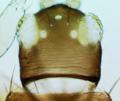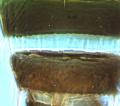Frankliniella tenuicornis
Recognition data
Distinguishing features
Both sexes fully winged. Female dark brown, tibiae, tarsi and antennal segment III largely yellow; fore wing pale with dark setae; male mainly yellow with brown markings. Head slightly longer than wide, projecting weakly in front of eyes; three pairs of ocellar setae present, pair III as long as anterolateral margin of ocellar triangle, arising just anterior to lateral margins; postocular setae pair I present, pair IV as long as diameter of one hind ocellus. Antennae 8-segmented; segments III–IV with sensorium forked, VIII scarcely longer than VII. Pronotum with 5 pairs of major setae; anteromarginal setae distinctly shorter than anteroangulars, one pair of minor setae present medially between posteromarginal submedian setae. Metanotum with 2 pairs of setae at anterior margin, campaniform sensilla absent. Fore wing with 2 complete rows of veinal setae. Abdominal tergites IV–VIII with paired ctenidia, on VIII anterolateral to spiracle; tergite VIII with no posteromarginal comb of microtrichia. Sternites III–VII without discal setae.
Related and similar species
F. tenuicornis is one of the few species of Frankliniella that is associated with grasses, and unlike most other members of the genus the head projects forward slightly in front of the compound eyes. Currently 230 species are listed in the genus Frankliniella, with up to 130 further names placed into synonymy (Nakahara, 1997). This high rate of synonymy has been due to unrecognized variability in size and color of so many species. Scarcely ten of these species are considered not native to the Americas, and F. tenuicornis is possibly one of these.
Taxonomic data
Current valid name
Frankliniella tenuicornis (Uzel)
Original name and synonyms
- Physopus tenuicornis Uzel, 1895: 99
- Physopus nervosa Uzel, 1895: 32
- Thrips (Euthrips) maidis Beach, 1896: 218
Family placement
Thripidae, Thripinae
Common names
European grass thrips
Biological data
Life history
Breeding in the florets of grasses
Host plants
Apparently on a wide range of Poaceae, including cereal crops
Tospoviruses vectored
None
Crop damage
Sometimes associated with damage to grass seed.
Distribution data
Area of origin
Europe, or possibly Palaearctic.
Distribution
Generally distributed across the northern hemisphere, extending south to the Mediterranean area and to Japan, and in North America to Florida and California.






